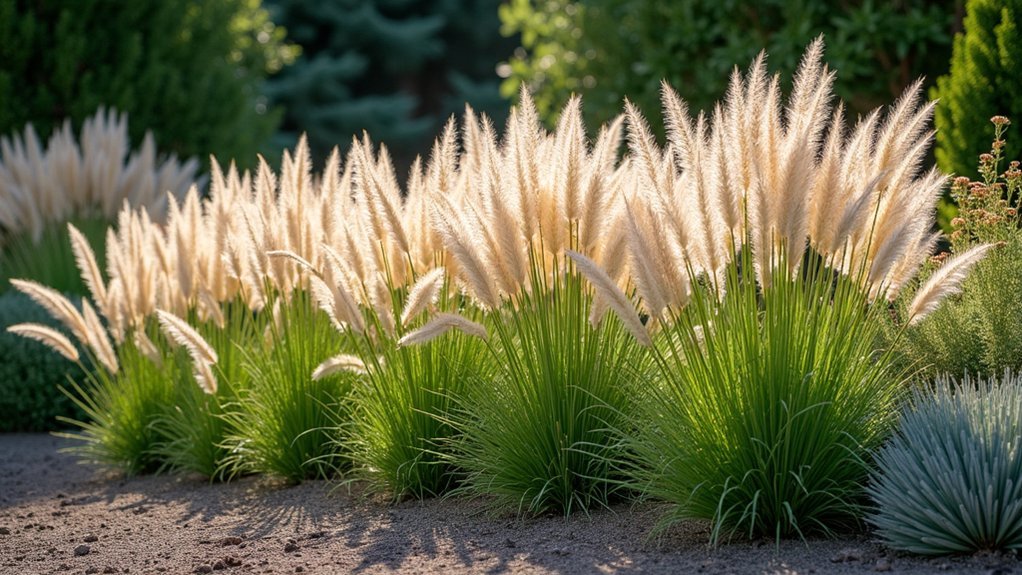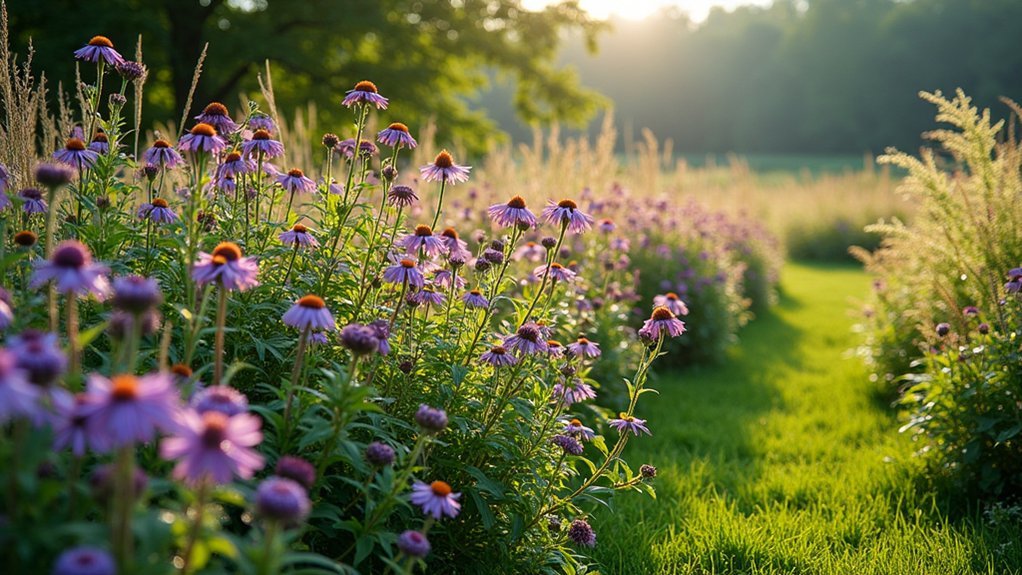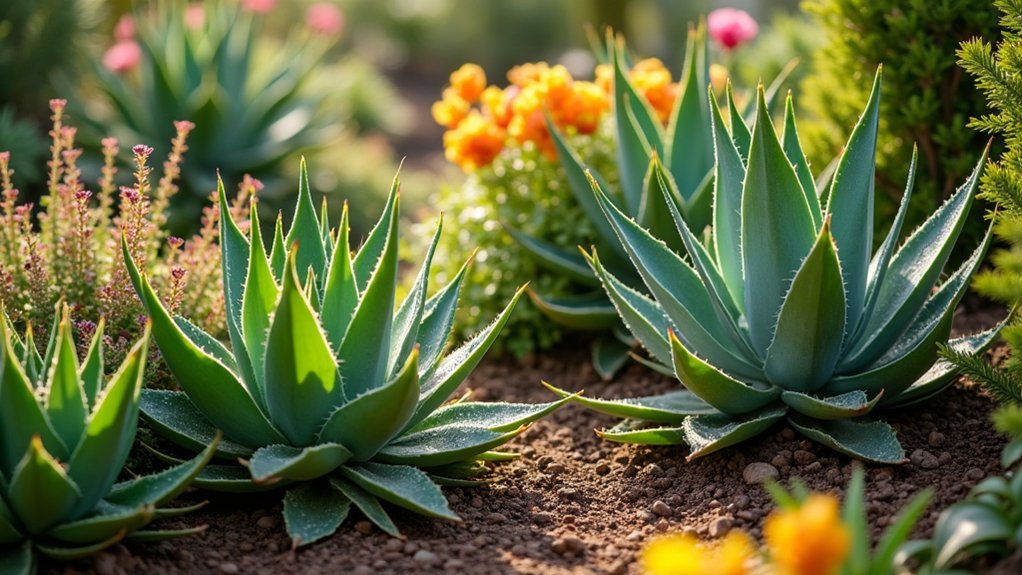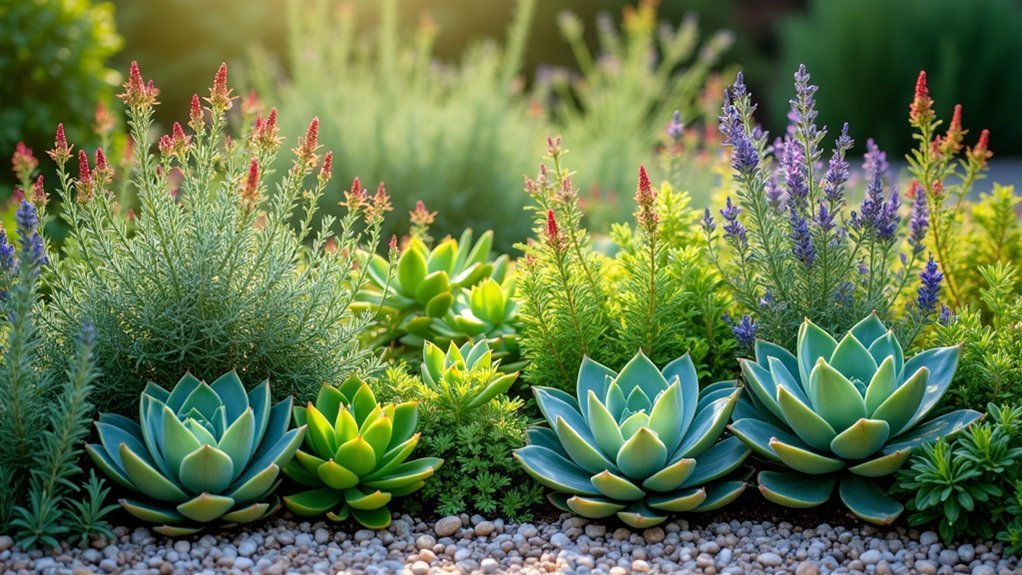For deer-proof borders requiring minimal care, you’ll find success with aromatic herbs like lavender and rosemary, ornamental grasses such as Blue Fescue and Switchgrass, or evergreen shrubs like Boxwood and Juniper. Native perennials including Purple Coneflower and Black-eyed Susan also resist deer while thriving with little attention. For coastal areas, try salt-tolerant options like Sea Oats and Russian Sage. These plants combine deer resistance with drought tolerance for truly low-maintenance boundaries.
Drought-Tolerant Ornamental Grasses for Deer-Resistant Borders

When creating a deer-resistant landscape, ornamental grasses offer an unbeatable combination of beauty and practicality.
These drought-tolerant plants require minimal maintenance while providing attractive borders that deer typically avoid.
Perfect for the busy gardener who wants beauty without becoming a deer’s buffet.
Blue Fescue thrives in poor soils, creating fine-textured blue-green borders that naturally repel hungry deer.
For taller privacy screens, consider Switchgrass, which adapts to various soil conditions and reaches heights of 3-6 feet.
Little Bluestem delivers stunning fall color at 2-4 feet tall and withstands dry conditions that many other plants can’t tolerate.
Miscanthus grows even taller—up to 6 feet—with showy plumes that add visual interest while deterring deer.
For shorter borders, Sideoats Grama’s unique seed spikes create eye-catching texture at just 1-2 feet tall.
Evergreen Shrubs That Naturally Repel Deer
Creating effective deer barriers becomes easier with evergreen shrubs that offer year-round protection and visual appeal. Boxwood provides consistent color and texture in your landscape while earning top marks for deer resistance.
You’ll find hardy evergreens like junipers particularly valuable, as their aromatic foliage naturally deters browsing deer while serving as excellent privacy screens.
False cypress presents another minimal care option with its attractive foliage and adaptability to various garden styles. The natural oils in juniper needles make them especially deer-resistant, allowing you to establish reliable borders without constant vigilance.
For lower-growing options, consider potentilla—this tough shrub produces cheerful yellow flowers while remaining unappetizing to deer. These deer-resistant choices guarantee your borders maintain their beauty without becoming a wildlife buffet.
Native Perennials for Low-Maintenance Deer Barriers

You’ll find remarkable value in native perennials that establish effective deer barriers while demanding minimal attention.
Plants like Yarrow and Catmint offer drought resistance and naturally spread to create denser boundaries that deer consistently avoid throughout the seasons.
Purple Coneflower and Black-eyed Susan strengthen your garden’s perimeter with their deer-deterrent properties while expanding naturally without additional work from you.
Drought-Tolerant Boundary Choices
Native perennials offer the perfect solution for gardeners seeking deer-resistant border plants that won’t drain your time or water resources.
Purple Coneflower and Giant Hyssop attract pollinators while thriving in well-drained soil with minimal care.
You’ll appreciate how Yarrow and Russian Sage flourish in full sun conditions, requiring little water once established while naturally deterring deer.
Their drought-tolerant nature makes them ideal for low-maintenance borders.
For aromatic protection, consider Catmint and Wood Sage, which provide vibrant blooms throughout the growing season while naturally repelling deer.
When planning for hot spots, incorporate Sun Drops to add cheerful yellow flowers that withstand heat and drought.
Tall Verbena creates a stunning visual barrier that deer avoid, while simultaneously attracting butterflies to enhance your garden’s biodiversity.
Year-Round Deer Resistance
While seasonal gardens often struggle with deer damage, establishing a perimeter of native perennials provides reliable protection throughout all four seasons. You’ll find that aromatic foliage plants like Catmint and Anise Hyssop naturally repel deer while requiring minimal attention in your low-maintenance landscape.
| Season | Best Deer-Resistant Plants | Benefits |
|---|---|---|
| Spring | Salvia, Boxwood | Early color, structural elements |
| Summer | Echinacea, Bee Balm | Drought-tolerant, attracts pollinators |
| Fall/Winter | Russian Sage, Juniper | Year-round deer resistance, winter interest |
Native perennials offer the perfect combination of deer-resistant garden appeal and self-sufficiency. By selecting these hardy species, you’ll create boundaries that deter hungry deer while simultaneously enhancing your garden’s ecological value with minimal intervention required from you.
Spreading Without Maintenance
Creating a self-sustaining deer barrier doesn’t require constant attention when you select the right native perennials. Plants like Echinacea and Rudbeckia naturally spread over time, forming dense patches that deer avoid while requiring minimal intervention from you.
Choose deer-resistant plants such as Yarrow and Bee Balm that thrive in full sun and establish robust root systems. These drought-tolerant options will expand gradually, filling empty spaces and crowding out weeds without your help.
Catmint and Salvia deter browsing with their fragrant foliage while attracting beneficial pollinators.
For a visually appealing border that stands up to deer pressure, incorporate Butterfly Bush and Spirea. These sturdy perennials create a sustainable landscape that adapts to local conditions, eliminating the need for chemical repellents or continuous maintenance as they naturally colonize your garden’s perimeter.
Aromatic Herbs That Double as Deer Deterrents

Aromatic herbs offer you a winning combination of drought-tolerance and natural deer-repelling properties through their strong scents and essential oils.
You’ll find herbs like lavender and rosemary flourish with minimal watering once established, creating fragrant borders throughout spring and summer while maintaining their deterrent qualities year-round.
Their varied growth patterns allow you to create layered plantings, with low-growing thyme as ground cover and taller varieties like anise hyssop providing vertical interest while collectively forming an aromatic barrier deer naturally avoid.
Drought-Tolerant Herb Options
If you’re struggling with both deer problems and dry conditions, aromatic herbs offer an elegant solution for your garden borders.
Lavender and catmint create stunning drought-tolerant boundaries with their aromatic foliage that naturally repels hungry deer.
Culinary favorites like rosemary, sage, thyme, and oregano thrive with minimal attention in dry environments.
Their strong scents act as natural deer-resistant barriers while providing fresh ingredients for your kitchen.
You’ll appreciate how these low-maintenance plants survive through hot, rainless periods when other border plants might wither.
For a beautiful border that serves multiple purposes, mix various herbs to support pollinators while keeping deer at bay.
Consider adding mint and basil to complete your collection—they’ll enhance your garden’s visual appeal while providing practical benefits for cooking and pest control.
Natural Repellent Properties
While all plants produce natural compounds, aromatic herbs contain potent essential oils that function as deer deterrents in your garden borders. Lavender, catmint, and rosemary emit strong scents that deer consistently avoid, creating an invisible barrier around your prized plantings.
You’ll appreciate how these fragrant oils serve dual purposes—repelling hungry deer while attracting beneficial pollinators that enhance your garden’s ecosystem.
When planting herbs like thyme and sage strategically alongside ornamental flowers, you’re establishing a deer-resistant perimeter that requires minimal attention.
Many of these aromatic herbs thrive with little water once established, making them perfect low-maintenance border options.
For added versatility, consider growing mint and basil in containers, which prevents unwanted deer browsing while providing fresh culinary ingredients for your kitchen.
Seasonal Growth Patterns
Throughout the gardening year, you’ll find that deer-resistant aromatic herbs display distinct seasonal rhythms that enhance their effectiveness as border protections.
Plants like lavender, catmint, and rosemary emerge in spring, providing early protection when deer are hungriest.
These aromatic herbs thrive in full sun positions with well-drained soil, requiring minimal care once established. You’ll enjoy continuous color from late spring through early fall as different varieties bloom in succession.
Their drought-tolerant nature means they’ll flourish even during summer heat when other plants struggle.
The seasonal growth patterns of these herbs create a dynamic deer deterrent system while simultaneously attracting beneficial pollinators to your garden.
As temperatures cool in fall, many herbs like sage and thyme maintain their aromatic qualities, ensuring year-round protection with virtually no maintenance required.
Textured Foliage Plants Deer Avoid

Because deer rely heavily on smell and texture when selecting food, plants with rough, fuzzy, or leathery foliage often escape their menu.
Boxwood offers year-round structure with its textured foliage and serves as highly deer resistant border plants that can define your landscape’s edges beautifully.
You’ll find Juniper’s aromatic needles provide excellent groundcover while deterring deer through their strong scent.
Russian Sage thrives in full sun, bringing silvery foliage and visual interest to your borders.
For shadier areas, consider Fringed Bleeding Heart with its unique heart-shaped flowers that deer typically avoid.
Don’t overlook Anise Hyssop—this dual-purpose plant features fragrant leaves that repel deer while attracting beneficial pollinators.
Most of these textured plants prefer moist soil initially but become relatively drought-tolerant once established.
Year-Round Color From Deer-Resistant Border Plants
Since most homeowners dream of gardens that remain vibrant across seasons, deer-resistant border plants offer an ideal solution for year-round color without sacrificing your landscape to hungry visitors.
Evergreens like Juniper and False Cypress maintain their appeal throughout all seasons while thriving in various soil conditions with minimal maintenance.
You’ll enjoy late summer to fall blooms from flowering shrubs such as Spirea and Butterfly Bush, which attract pollinators but deter deer.
For mid-summer color, incorporate perennials like Echinacea and Salvia—these drought-tolerant options feature aromatic foliage that deer typically avoid.
Boxwood provides consistent texture and structure regardless of season.
To enhance your garden’s aesthetic while reducing deer damage, combine these strategic plantings of shrubs and perennials.
This approach guarantees your borders remain colorful and intact year-round.
Thorny and Prickly Plants for Natural Deer Protection

When creating natural deterrents against deer, thorny and prickly plants serve as your garden’s first line of defense. These deer-resistant options, like barberry and Oregon grape, create effective physical barriers while requiring minimal attention.
Nature’s defense system at work: prickly plants create living barriers that deer instinctively avoid.
You’ll appreciate that most thorny plants thrive in harsh climates and poor soil conditions, making them ideal low-maintenance additions to your landscape.
For maximum garden security and seasonal interest, consider:
- Hawthorn shrubs that surprise with beautiful spring blooms followed by vibrant berries that persist through winter
- Blackthorn hedges that create impenetrable boundaries while supporting local biodiversity
- Drought-tolerant barberry varieties that offer striking foliage colors throughout the seasons with virtually no care
Position these prickly plants strategically along borders to create protective, wildlife-friendly barriers that deer won’t dare to cross.
Salt-Tolerant Deer-Proof Options for Coastal Gardens
Coastal gardens face dual challenges of salt exposure and deer browsing, but you’ll find excellent protection with native drought-resistant plants like Sea Oats that stabilize sandy soil while deterring deer.
Succulent options such as Beach Strawberry offer ground-covering benefits with their thick, salt-tolerant foliage that deer typically avoid.
Silver-leafed varieties, including Russian Sage, provide striking visual interest while their aromatic foliage and ability to thrive in poor coastal soils make them particularly valuable deer-resistant choices.
Drought-Resistant Coastal Natives
Gardeners living along shorelines face unique challenges that demand specialized plant selections. Coastal native plants offer the perfect solution, combining drought tolerance with deer resistance. Beach Strawberry and Saltbush thrive in salt-laden environments while requiring minimal irrigation once established, making them ideal for low-maintenance borders.
For your coastal landscape, consider these outstanding performers:
- Muhly Grass – Creates stunning textural contrasts while standing up to both salt spray and browsing deer.
- Lavender and Rosemary – Their aromatic foliage naturally deters deer while attracting beneficial pollinators.
- Sea Thrift – Delivers vibrant blooms in harsh conditions without requiring constant attention.
These salt-tolerant options provide beauty and function with minimal care requirements—a perfect combination for coastal gardens where time and resources are better spent enjoying the ocean view.
Succulent Ocean-Edge Options
Living by the ocean doesn’t mean you can’t have beautiful, low-maintenance borders. Sempervivum (Hens and Chicks) offers unique rosette shapes that thrive in coastal conditions while remaining unappealing to deer. These succulents require minimal attention and excel in well-drained sandy soils.
Pair them with Beach Strawberry (Fragaria chiloensis), which provides ground cover and produces edible fruit while withstanding salt exposure.
For texture, incorporate Blue Fescue with its striking blue-gray foliage that deer avoid thanks to its coarse texture.
Consider planting salt-tolerant Sea Oats for height and dune stabilization, or add drought-tolerant Lavender for its fragrant foliage that deters deer while attracting pollinators.
These deer-proof options create stunning borders that withstand challenging oceanside environments with minimal care required.
Silver-Leafed Salt Survivors
Shimmering like beacons in coastal landscapes, silver-leaved plants offer remarkable resilience against both salt spray and hungry deer.
These salt-tolerant champions thrive where other plants struggle, making them perfect for your low-maintenance borders. Russian Sage and Dusty Miller stand out as exceptional choices, while Silver Lining White Sagebrush repels deer with its aromatic properties.
- Peace of mind – Create worry-free coastal gardens with deer-resistant varieties that need minimal attention yet deliver maximum impact
- Year-round beauty – Enjoy consistent texture and color even during harsh coastal conditions when other plants falter
- Sustainable solutions – Reduce water usage and maintenance time while still maintaining an elegant landscape that withstands nature’s challenges
Pair these silver-leafed plants with Sea Oats and Beach Strawberry for a complete deer-proof border that survives and thrives.
Shade-Loving Plants Deer Won’t Touch
While creating a beautiful landscape in shadier parts of your yard can be challenging enough, dealing with deer adds another layer of complexity.
Fortunately, several shade-loving plants offer both beauty and deer-resistance with minimal care.
Japanese Pachysandra delivers glossy foliage that thrives in partial shade to full shade areas, spreading quickly as an effective ground cover.
For texture, try Japanese Painted Fern with its striking silver-gray fronds that deer typically avoid.
Lily of the Valley produces fragrant bell-shaped flowers and bright berries while requiring little maintenance in shadier spots.
Don’t overlook Fringed Bleeding Heart with its distinctive heart-shaped flowers that add visual interest to woodland gardens.
Lady’s Mantle rounds out your options with its chartreuse blooms and soft-haired leaves that deer find unappealing, performing well even in partial shade conditions.
Deer-Resistant Ground Covers for Border Edges
The perfect border edge combines both functionality and beauty, creating a seamless passage between garden features while deterring hungry deer.
Consider Japanese Pachysandra or Ajuga (Bugleweed) for their versatile growth in partial shade to full shade conditions. Both spread efficiently while maintaining bright green foliage that deer avoid.
For more diverse options, you’ll find these deer-resistant ground covers particularly effective:
- Creeping Thyme – Offers fragrant appeal while attracting pollinators with its delicate purple blooms
- Lily of the Valley – Produces charming bell-shaped flowers amid lush green foliage, thriving where other plants struggle
- Periwinkle (Vinca minor) – Delivers year-round interest with evergreen leaves and striking blue flowers, adapting to various light conditions
These low-maintenance options create beautiful borders while naturally deterring deer from your garden edges.
Frequently Asked Questions
What Are Low Maintenance Deer Resistant Flowers for Pots?
You’ll love these low maintenance, deer resistant flowers for pots: Signet Marigold with its citrus scent, drought-tolerant Lavender, pollinator-friendly Bee Balm, water-efficient Catmint, and hardy Russian Sage that thrives in poor soil.
What Are Low Maintenance Deer Resistant Shade Shrubs?
You’ll love these low-maintenance, deer-resistant shade shrubs: Japanese Pieris, Boxwood, Mountain Laurel, Inkberry Holly, and Rhododendron. They require minimal care while providing year-round structure and texture in shaded garden areas.
What Plant Do Deer Hate Most?
While deer hate many plants, they’re most repelled by monkshood due to its high toxicity. You’ll find they completely avoid its poisonous compounds, making it one of the most deer-resistant options for your garden.
What Is the Best Ground Cover That Deer Won’t Eat?
You’ll find Creeping Juniper ideal as deer-resistant ground cover. It’s low-maintenance and drought-tolerant. Japanese Pachysandra, Ajuga, and Lily of the Valley are excellent shade options that deer typically avoid.
In Summary
You’ll find that deer-resistant borders don’t have to be maintenance nightmares. Whether you’ve chosen aromatic herbs, prickly barriers, or textured foliage plants, these options require minimal attention while keeping deer at bay. By selecting plants that naturally repel deer and match your specific growing conditions, you’re creating sustainable, low-maintenance borders that protect your prized garden without demanding constant care or vigilance.





Leave a Reply